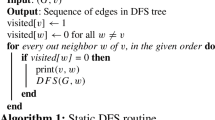Abstract
We present a deterministic Logspace procedure, which, given a bipartite planar graph on n vertices, assigns O(log n) bits long weights to its edges so that the minimum weight perfect matching in the graph becomes unique. The Isolation Lemma as described in Mulmuley et al. (Combinatorica 7(1):105–131, 1987) achieves the same for general graphs using randomness, whereas we can do it deterministically when restricted to bipartite planar graphs. As a consequence, we reduce both decision and construction versions of the perfect matching problem in bipartite planar graphs to testing whether a matrix is singular, under the promise that its determinant is 0 or 1, thus obtaining a highly parallel \(\mathsf{SPL}\) algorithm for both decision and construction versions of the bipartite perfect matching problem. This improves the earlier known bounds of non-uniform \(\mathsf{SPL}\) by Allender et al. (J. Comput. Syst. Sci. 59(2):164–181, 1999) and \(\mathsf{NC}\) 2 by Miller and Naor (SIAM J. Comput. 24:1002–1017, 1995), and by Mahajan and Varadarajan (Proceedings of the Thirty-Second Annual ACM Symposium on Theory of Computing (STOC), pp. 351–357, 2000). It also rekindles the hope of obtaining a deterministic parallel algorithm for constructing a perfect matching in non-bipartite planar graphs, which has been open for a long time. Further we try to find the lower bound on the number of bits needed for deterministically isolating a perfect matching. We show that our particular method for isolation will require Ω(log n) bits. Our techniques are elementary.
Similar content being viewed by others
References
Allender, E., Barrington, D.A.M., Chakraborty, T., Datta, S., Roy, S.: Grid graph reachability problems. In: IEEE Conference on Computational Complexity, pp. 299–313 (2006)
Allender, E., Datta, S., Roy, S.: The directed planar reachability problem. In: FSTTCS, pp. 238–249 (2005)
Allender, E., Reinhardt, K., Zhou, S.: Isolation, matching, and counting: uniform and nonuniform upper bounds. J. Comput. Syst. Sci. 59(2), 164–181 (1999)
Braverman, M., Kulkarni, R., Roy, S.: Parity problems in planar graphs. In: IEEE Conference on Computational Complexity, pp. 222–235 (2007)
Bourke, C., Tewari, R., Vinodchandran, N.V.: Directed planar reachability is in unambiguous log-space. In: IEEE Conference on Computational Complexity, pp. 217–221 (2007)
Datta, S., Kulkarni, R., Limaye, N., Mahajan, M.: Planarity, determinants, permanents, and (unique) matchings. In: CSR, pp. 115–126 (2007)
Diestel, R.: Graph Theory. Springer, Berlin (2005)
Grigoriev, D., Karpinski, M.: The matching problem for bipartite graphs with polynomially bounded permanent is in \(\mathsf{NC}\) . In: Proceedings of 28th IEEE Conference on Foundations of Computer Science, pp. 166–172. IEEE Computer Society Press, Los Alamitos (1987)
Gottlob, G., Leone, N., Scarcello, F.: Theor. Comput. Sci. Arch. 270(1–2), 761–777 (2002)
Kasteleyn, P.W.: Graph theory and crystal physics. In: Harary, F. (ed.) Graph Theory and Theoretical Physics, pp. 43–110. Academic Press, New York (1967)
Kenyon, R.W., Propp, J.G., Wilson, D.B.: Trees matchings. Electron. J. Comb. 7(1)
Karp, R., Upfal, E., Wigderson, A.: Constructing a perfect matching is in random \(\mathsf{NC}\) . Combinatorica 6, 35–48 (1986)
Kozen, D., Vazirani, U.V., Vazirani, V.V.: \(\mathsf{NC}\) algorithms for comparability graphs, interval graphs, and testing for unique perfect matching. In: FSTTCS, pp. 496–503 (1985)
Lovasz, L., Plummer, M.: Matching Theory. North-Holland, Amsterdam (1986)
Miller, G., Naor, J.: Flow in planar graphs with multiple sources and sinks. SIAM J. Comput. 24, 1002–1017 (1995)
Mahajan, M., Vinay, V.: A combinatorial algorithm for the determinant. In: SODA, pp. 730–738 (1997)
Mahajan, M., Varadarajan, K.: A new \(\mathsf{NC}\) algorithm to find a perfect matching in planar and bounded genus graphs. In: Proceedings of the Thirty-Second Annual ACM Symposium on Theory of Computing (STOC), pp. 351–357 (2000)
Mulmuley, K., Vazirani, U., Vazirani, V.: Matching is as easy as matrix inversion. Combinatorica 7(1), 105–131 (1987)
Vazirani, V.: \(\mathsf{NC}\) algorithms for computing the number of perfect matchings in K 3,3-free graphs and related problems. In: SWAT, pp. 233–242 (1988)
Vollmer, H.: Introduction to Circuit Complexity—A Uniform Approach; Texts in Theoretical Computer Science. An EATCS Series. Springer, Berlin (1999)
Author information
Authors and Affiliations
Corresponding author
Additional information
This work was done while the second author was visiting Chennai Mathematical Institute.
Rights and permissions
About this article
Cite this article
Datta, S., Kulkarni, R. & Roy, S. Deterministically Isolating a Perfect Matching in Bipartite Planar Graphs. Theory Comput Syst 47, 737–757 (2010). https://doi.org/10.1007/s00224-009-9204-8
Received:
Accepted:
Published:
Issue Date:
DOI: https://doi.org/10.1007/s00224-009-9204-8




